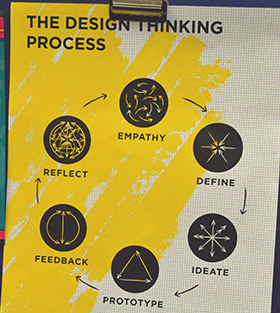Three classrooms, a memory bench and a sidewalk. Those are elements in ninth-graders Diamond Johnson, Madisyn Rogers and Jamya Sanders’ design for a greenhouse-themed outdoor addition to their school.
“(Students and teachers) said they’d rather be outside and get fresh air,” Jamya said.
Making Math Add Up is a continuing series of School News Network
|
Stages of Design Thinking
|
The girls worked on the prototype for an outdoor learning space during teacher David Moncada’s algebra class, where math is being used in many more ways than equations on a sheet of paper.
His students used the Design Thinking process, which involves developing a deep understanding of their users’ lives and unmet needs, to plan an area for students to learn outside.
Following the steps of the process, they surveyed peers and teachers to see if they wanted an outdoor space and, if so, what they wanted it to include. Madisyn said they used survey information to come up with their prototype, including a tinted glass roof so the area stays dry and can be equipped with technology.
Incorporating algebra, they calculated area, perimeter, volume and scale factor to create their designs to transform the school’s courtyard into learning space. Students also worked within the parameters of a budget, computing average costs of all items.
Groups recently presented their designs to a panel of judges, including Moncada, Principal Chad Conklin, Facilities Director Glenn Bachelder and other staff members.
The judges named finalists from each class. Finalists will receive movie theater gift cards. Each member in the grand prize winning group, which was to be determined by teachers today, Jan. 12, will receive $50.

Planning for a Real Outdoor Classroom
The goal is to eventually present a design to the Board of Education and have students’ ideas incorporated into an outdoor space.
“I think that would be cool if you got to come up with an idea that you’re going to use. It would be our legacy that we leave,” Madisyn said
Diamond said she would like to have a positive impact. “It might benefit some other students’ learning, and you can find projects outside you can’t do inside.”
“It would be interesting to see them create it and if they use our ideas,” said Jamya.
Moncada attended a training on Design Thinking in the classroom offered by the the Kent ISD Career Readiness Department last summer.
“One of the best ways to learn is to be exposed to real-life things,” he said. “In math class we have a lot of story problems; a lot of them are hypothetical. This is an actual real problem they are working on. They can see their design actually be implemented at some point.”

Moncada plans to use Design Thinking throughout the school year, basing projects around ideas that work to meet the needs of other people after researching their perspectives and point of view. Students have to work together, problem-solve, use creativity and present their findings.
“They are learning more than just math,” he said. “They are learning science, technology, how to do research, how to seek what they need and implement it. They are building things, working with their hands.”
Students grow in more than just math as a result, Moncada added.
“You grow as a person in a lot of different ways. It’s been really nice to see how creative they are. They come up with things I hadn’t thought about. They feed off each other. They take each other’s ideas and then add to them.
“It helps the students in a very holistic way.”
CONNECT
Example of District-wide Design Thinking










